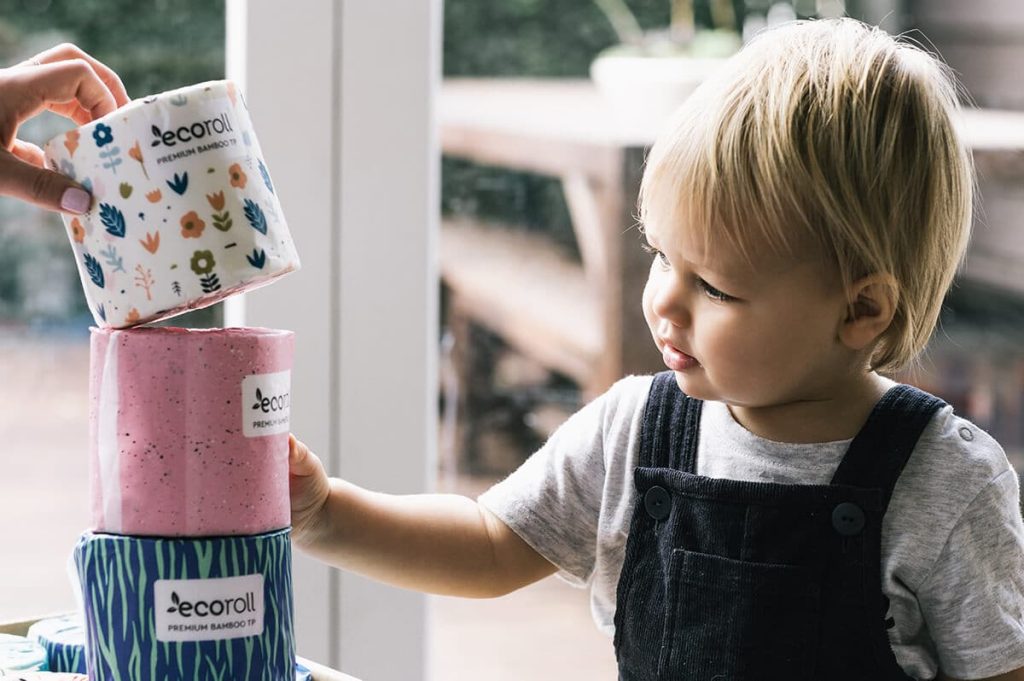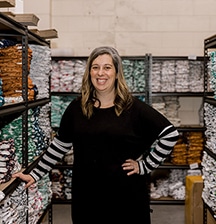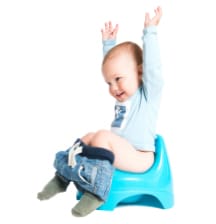
Children will generally be ready to start toilet training sometime between the ages of 18-months and 3-years, but bear in mind that different children are ready for toilet training at different stages, and the time it takes them to learn to use the toilet properly will also vary. Here are some steps to help you make the transition as easy and stress-free as possible for your child.
Step 1: wait for signs of readiness
Don’t be tempted to start the process if your child isn’t interested or showing any of the ‘readiness signs’ (see box above), and try to avoid ‘peer pressure’ from other mums whose kids are already trained. Never force your child to sit on the potty/toilet against their will. All children will eventually toilet train – starting too early can cause extra frustration and problems.
Step 2: choose the right time
Toilet training can be a frustrating and time-consuming process for many parents, as well as being quite hard work for some children. To minimise distractions and the risk of accidents, and to allow plenty of opportunity for successes, start toilet training at a time when you can stay close to home for a few days. And it’s not a good idea to start toilet training when there are other stressful changes going on, such as the arrival of a new baby, the start of preschool, a big trip away or moving house.
Step 3: talk to your child
Make sure you take the time to explain to your child what is going to happen and ensure before you start that they understand the language associated with toilet training and the body parts that you are going to be referring to. They will also need to be able to follow simple instructions, such as “pull down your pants”.
Step 4: products and preparation
These days, there are many things you can buy for your toilet-training toddler, including steps to reach the toilet, various shapes and sizes of potties (even musical ones), character toilet paper and fun reward charts. As well as handy waterproof bed covers and car seat covers for those inevitable accidents! Make sure you select products that are sturdy, safe and easy to use and easy to clean. Letting your child take part in the selection process might help them feel more involved and excited about toilet training.
Also, ensure the bathroom is safe from hazards and that all cleaning products and medicines are well out of reach.
Step 5: potty or toilet?
This will depend on your child. The benefits of using a potty (or a potty-chair which has more chair-like support and a removable bowl for ease of emptying) are that you can access it quickly, you can take it with you if you are going out and your child can easily hop on it themselves.
If using a toilet, some children do better sitting backwards on it and straddling it, with their hands on the tank of the toilet where they can rest a book or play with a toy. Playing and reading help take the pressure off the other end.
Just be sure that with both the potty and the toilet, their feet rest comfortably on the floor (or provide a footstool if necessary) because little legs dangling from toilets or high potties tighten rectal muscles, making defecation difficult.
Step 6: role-playing and imitation
Children learn by role-playing and imitation so if your child shows an interest in watching you use the toilet, show them how you sit on it and explain what you are doing. You could also use a doll or teddy to role-play sitting on the potty, wiping their bottom, etc. Talk them through the process, as it will help with their overall understanding.
Step 7: encouragement and perseverance
Stay positive throughout the training process and encourage your child to keep on going to the toilet or sitting on the potty. But don’t rely on them to tell you when they need to go, at least at first. You may choose to regularly sit your child on the toilet or potty for short periods (15-30 minutes after a meal is often the best time to catch a bowel motion), or ask them periodically if they would like to go.
Step 8: rewards and praise are essential
Small rewards (stickers, stamps, etc) and plenty of praise are among the best motivators for children. Use a chart to record successes. And never underestimate the impact of praise, excitement and cuddles from mum and dad.
Step 9: remember, accidents do happen
Accidents and mistakes are inevitable in the early stages of toilet training, but avoid getting angry or frustrated with your child. Instead, explain to your child that it was an accident and offer your support. Reassure your child that they are well on the way to using the potty successfully.
Step 10: don’t set a deadline
Every child will learn to use the toilet in their own time. The important thing is not to put pressure on your child to be successful by a set date or in time for a certain event, such as a holiday or the start of preschool. This will only add extra frustration and anxiety to the process and can lead to disappointment.
Bedwetting
Supportive toilet training lays a good foundation for lifelong continence. In spite of parents’ best efforts at toilet training, a small number of children will have problems with wetting and/or soiling. Bedwetting is particularly common.
“They’ll grow out of it” is the advice often given to parents by family, friends and some health professionals. Each year, around 15% of children who wet the bed become dry at night without any intervention, but many do not. A family history of bedwetting does make “growing out of it” more likely, but often at an older age. If one parent was a bedwetter, there is a 44% chance of the child bedwetting; if both parents were bedwetters, this increases to 77%.
Children often feel as if they are ‘the only one’, but 15% of 5-year-olds, 5% of 10-year-olds and 2% of 15-year-olds wet the bed.
Supported bed alarm programmes are the gold standard treatment for bedwetting (whatever the cause) and have a 70-80% success rate. A motivated child increases the chances of becoming dry. Alarm programmes are usually commenced at age 7.
The most important aspect of managing any children’s continence problem is thorough assessment. A visit to the family GP can rule out urinary tract infection and constipation. Some of the main centres have private continence advisors, but for school-aged children, the school Public Health Nurse can help with toileting and bed alarm programmes, education and resources for parent, child and school.
For more information on wetting and soiling, to participate in the parent forum, or to view a nationwide database of continence advisors and nurses, see the New Zealand Continence Association website www.continence.org.nz, or phone 0800 650 659. KEEA, the children’s division of NZCA, will be publishing a children’s picture book on bedwetting which will be available through the website in the next few months.
By Jacqueline Brown








